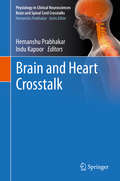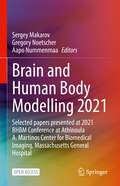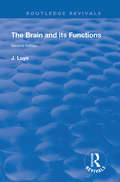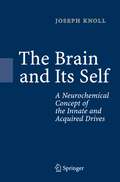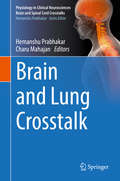- Table View
- List View
Brain and Behavior in Child Psychiatry
by Aribert RothenbergerThe Brain-What Else! All senses are connected with the brain. From sense-perception derives . . . knowledge. In the brain is the sovereignty ofthe mind. Mind is interpreted by the brain. AIcmaeon of Croton (5th Century B. c. ) The ground is shifting under the traditional approaches to problems in the philosophy of mind. Earlier doctrines concerning the independence of cognition from the brain now appear untenable. P. S. Churchland (20th Century A. D. ) It is not objective of this volume to discuss the history and significance of neuroscience for philosophy from a developmental perspective, although this would be a rather interesting topic. Its object is the relationship between brain and behavior in children as exhibited by higher mental functions (e. g. , speech and language; reasoning, perception, free will and control of motor acts, dependence of behavior on neuronal constraints, the self of the child and therapeutic acti vi ties). Child psychiatrists commonly allude to the brain as the site of disturbance responsible for many developmental disabilities and psychopathological syn dromes identifiable by observing behavior (e. g. , dyslexia, delusions), neurological examination (e. g. , soft signs), psychological test performance (e. g. , Bender Gestalt Test), EEG (e. g. , alpha-theta ratio), and CCT (e. g. , pseudoatrophy). While there is nothing inherently wrong with such inferences, the fact is frequently overlooked that there is no specific set of brain-behavior relationships validating these inferences.
Brain and Conscious Experience: Study Week September 28 to October 4, 1964, of the Pontificia Academia Scientiarum
by John C. EcclesThe planning of this Study Week at the Pontifical Academy of Science from September 28 to October 4, 1964, began just two years before when the President, Professor Lemaitre, asked me if 1 would be responsible for a Study Week relating Psychology to what we may call the Neurosciences. 1 accepted this responsibility on the understanding that 1 could have as sistance from two colleagues in the Academy, Professors Heymans and Chagas. Besides participating in the Study Week they gave me much needed assistance and advice in the arduous and, at times, perplexing task that 1 had undertaken, and 1 gratefully acknowledge my indebtedness to them. Though there have been in recent years many symposia concerned with the so-called higher functions of the brain, for example with percep tion, learning and conditioning, and with the processing of information in the brain, there has to my knowledge been no symposium specifically with brain functions and consciousness since the memorable treating Laurentian Conference of 1953, which was later published in 1954 as the book, "Brain Mechanisms and Consciousness.
The Brain and Conscious Unity: Freud's Omega
by Petr BobIn this provocative text, a noted neuroscientist reexamines Freud's posthumously published Project of Scientific Psychology in the light of modern neuroscience. This expanded "thermodynamics of the mind" model includes robust conceptions of the cellular and neural processes that accompany creation of consciousness and memory, their contributions to such conditions as depression, dissociative disorders, and schizophrenia, and implications for practice, from imaging to talk-based therapies to pharmacotherapy. Central to this construct is Freud's proposal of specific "omega" neurons as the most volatile carriers of consciousness between mind and brain, which is applied to current issues regarding complexity and executive functioning. In addition, the book is extensively referenced, allowing readers to investigate these and related phenomena in greater detail.Among the topics covered:Neural reductionism in Freud's "Project" and neuropsychoanalysis.Thermodynamics and brain self-organization.Conflicting information and the dissociated mind.The Cartesian model of the mind and the binding problem.Neuroendocrine and immune response to stress.The concept of omega neurons and modern chaos theory.Rigorous, challenging, and occasionally startling, The Brain and Conscious Unity is a milestone in the neuroscience and mind/brain literature to be read and discussed by psychiatrists, psychologists, and neuropsychologists.
Brain and Health Informatics: International Conference, BHI 2013, Maebashi, Japan, October 29-31, 2013. Proceedings (Lecture Notes in Computer Science #8211)
by Kazayuki Imamura Shiro Usui Tomoaki Shirao Takuji Kasamatsu Lars Schwabe Ning ZhongThis book constitutes the refereed proceedings of the International Conference on Brain and Health Informatics, BHI 2013, held in Maebashi, Japan, in October 2013. The 33 revised full papers presented together with 8 workshop papers and 12 special session papers were carefully reviewed and selected for inclusion in the book. The papers are organized in topical sections on thinking and perception-centric Investigations of human Information processing system; information technologies for curating, mining, managing and using big brain/health data; information technologies for healthcare; data analytics, data mining, and machine learning; and applications. The topics of the workshop papers are: mental health with ICT; and granular knowledge discovery in biomedical and active-media environments; and the topics of the special sessions are: human centered computing; neuro-robotics; and intelligent healthcare data analytics.
Brain and Heart Crosstalk (Physiology in Clinical Neurosciences – Brain and Spinal Cord Crosstalks)
by Hemanshu Prabhakar Indu KapoorThis book discusses the underlying mechanisms connecting the brain and heart. The physiology of the brain is such that it is easily affected by any altered physiology of other systems, which in turn may compromise cerebral blood flow and oxygenation. Together, the brain and heart control our body systems, allowing them to function automatically. This interaction between the brain and other systems makes it important for us to understand how any kind of injury to the brain can produce complications in remote organs or systems, such as the heart. The central nervous system is responsible for vegetative function and is central to homeostasis. Further, central nervous system responses are linked to the ongoing function of other organ systems e.g. feeding, thermoregulation, reproduction and muscle activity. It is therefore logical that neural control of the cardiovascular system must also interact with the neural control of other organ systems. This book explains in detail stressed cardiac conditions, discussing the pathophysiology and proposed treatment, and also describing lesser-known crosstalks between the acutely or chronically affected brain and heart.
Brain and Heart Infarct: Proceedings of the Third Cologne Symposium, June 16-19, 1976
by K. J. Zülch, W. Kaufmann, K.-A. Hossmann and V. HossmannWith contributions by numerous experts
Brain and Heart Infarct II
by K. J. Zülch, W. Kaufmann, K.-A. Hossmann and V. HossmannDr. Kaufmann and I wish to welcome you here in Schloss Auel to this second symposium on brain and heart infarct. We have chosen this lovely castle because I am always dissatisfied with meetings in great hotels in cities, where we rush to and from the meeting rooms. I had such an experience overseas just 3 weeks ago from 8 o'clock in the morning until 10 o'clock at night. We want you to feel some of the wonderful atmosphere of the Bergisches La~d. Moreover, we wanted like you to enjoy a bit of the spirit of the Rhein valley and the 2000-year-old city of Cologne, even at the expense of losing a few hours of discus sion; though this may be a quantitative loss, we feel sure that the environment of this city will stimulate our discussions. Two years ago we gathered here in Schloss Auel for the first time, attempting to conduct a discussion between neurologists and cardiologists on the similarities and dissimilarities of circulatory disorders of the brain and heart. We are happy to continue this discussi?n in the days to come.
Brain and Human Body Modeling: Computational Human Modeling at EMBC 2018
by Sergey Makarov Marc Horner Gregory NoetscherThis open access book describes modern applications of computational human modeling with specific emphasis in the areas of neurology and neuroelectromagnetics, depression and cancer treatments, radio-frequency studies and wireless communications. Special consideration is also given to the use of human modeling to the computational assessment of relevant regulatory and safety requirements. Readers working on applications that may expose human subjects to electromagnetic radiation will benefit from this book’s coverage of the latest developments in computational modelling and human phantom development to assess a given technology’s safety and efficacy in a timely manner.Describes construction and application of computational human models including anatomically detailed and subject specific models;Explains new practices in computational human modeling for neuroelectromagnetics, electromagnetic safety, and exposure evaluations;Includes a survey of modern applications for which computational human models are critical;Describes cellular-level interactions between the human body and electromagnetic fields.
Brain and Human Body Modeling 2020: Computational Human Models Presented at EMBC 2019 and the BRAIN Initiative® 2019 Meeting
by Gregory M. Noetscher Sergey N. Makarov Aapo NummenmaaThis open access book describes modern applications of computational human modeling in an effort to advance neurology, cancer treatment, and radio-frequency studies including regulatory, safety, and wireless communication fields. Readers working on any application that may expose human subjects to electromagnetic radiation will benefit from this book’s coverage of the latest models and techniques available to assess a given technology’s safety and efficacy in a timely and efficient manner.Describes computational human body phantom construction and application;Explains new practices in computational human body modeling for electromagnetic safety and exposure evaluations;Includes a survey of modern applications for which computational human phantoms are critical.
Brain and Human Body Modelling 2021: Selected papers presented at 2021 BHBM Conference at Athinoula A. Martinos Center for Biomedical Imaging, Massachusetts General Hospital
by Sergey Makarov Gregory Noetscher Aapo NummenmaaThis open access book describes modern applications of computational human modelling to advance neurology, cancer treatment, and radio-frequency studies including regulatory, safety, and wireless communication fields. Readers working on any application that may expose human subjects to electromagnetic radiation will benefit from this book’s coverage of the latest models and techniques available to assess a given technology’s safety and efficacy in a timely and efficient manner.This is an Open Access book.
The Brain and its Functions (Routledge Revivals)
by J LuysFirst published in 1881. The present work, on the structure and functions of the brain, is an abstract of the author's persoal experience as regards this subject. It is divided into two distinct parts; the first, anatomical, serves as the foundation of the work. It is followed by a second, purely physiological, which is its complement and necessary sequence. It includes chapters on the optic thalamus, the corpus striatum, and the memory in exercise.
The Brain and its Functions (Routledge Revivals)
by J LuysFirst published in 1881. The present work, on the structure and functions of the brain, is an abstract of the author's persoal experience as regards this subject. It is divided into two distinct parts; the first, anatomical, serves as the foundation of the work. It is followed by a second, purely physiological, which is its complement and necessary sequence. It includes chapters on the optic thalamus, the corpus striatum, and the memory in exercise.
The Brain and Its Self: A Neurochemical Concept of the Innate and Acquired Drives
by Joseph KnollThe main message of this monograph is that the appearance of the mammalian brain with the ability to acquire drives ensured the development of social life, and eventually led to the evolution of the human society. This most sophisticated form of organized life on earth is still in the trial and error phase of its development. It seeks to outgrow the myth-directed era of its history and come to its final state, the ration-directed human society.
Brain and Kidney Crosstalk (Physiology in Clinical Neurosciences – Brain and Spinal Cord Crosstalks)
by Hemanshu Prabhakar Nidhi GuptaThis book discusses normal brain physiology and renal physiology, as well as the interactions between the two. The physiology of the brain can easily be affected by any changes to the physiology of other systems, which in turn may compromise cerebral blood flow and oxygenation. Together the brain and the renal system help our body systems to function automatically. The book addresses the basic aspects of neurophysiology and renal physiology in three broad sections, the first of which covers the basic principles of cerebral physiology and neural regulation of the renal system. The second part reviews the normal physiology of the renal system, including the mechanism of action, while the last section summarizes the correlation between the brain and kidney. Highly informative and clearly structured, the book provides essential insights for anyone with an interest in physiology and medicine.
Brain and Longevity (Research and Perspectives in Longevity)
by Caleb E. Finch Jean-Marie RobineIn this third volume on longevity Fondation Ipsen has again collected the most recent results in research on genes and diet in the evolution of human longevity, educational level and longevity, cognitive impairment and survival at older age and other contributions. The preponderance of relatively short - compared to long-lived organisms suggests that morphogenesis is easier to accomplish than is maintenace of soma, whereas the broad range of longevities of organisms demonstrates that maintaining soma for extended periods of time is possible. The underlying assumption of "disposable soma" theory of aging is that the expense of maintaining somatic cells depends on their contribution to the welfare of the germ cells.
Brain and Lung Crosstalk (Physiology in Clinical Neurosciences – Brain and Spinal Cord Crosstalks)
by Hemanshu Prabhakar Charu MahajanThe central nervous system, which includes the brain and spinal cord, has a high metabolic demand. The physiology of the brain is such that it is easily affected by alterations in other systems, which in turn can compromise cerebral blood flow and oxygenation. Together the brain and spinal cord control the automatic function of our body systems. While other systems of body controls individual functions, central nervous system at the same time does many different functions, especially, controlling the function of other systems. This interaction between the brain and other systems is important when it comes to understanding how injuries to the brain can, at times, produce complications in remote organs or systems of the body, such as the lungs. This book explains the lesser-known crosstalks between acutely or chronically affected brain and lung, describing the pathophysiology of the lung following brain injury and discussing in detail the conflicts between the brain and lungs in relation to the tidal volumes, positive end-expiratory pressures, arterial carbon dioxide and oxygen levels, recruitment maneuvers and positioning, as well as potential therapeutic targets.
Brain and Mental Health in Ageing (Healthy Ageing and Longevity #21)
by Suresh I. S. Rattan Gurcharan KaurThis volume in the book series Healthy Ageing and Longevity focuses on the interaction and co-dependence of the brain and mental health during ageing. A wide-range of topics discussed here include conceptual and historical understanding, descriptive analyses, and evidence-based interventions for the maintenance, enhancement and recovery of the brain and mental health, especially in old age. The emphasis is on the effective biological and psycho-social lifestyle factors, and complementary medicine and traditional cultural practices that could be health beneficial. Potential readership includes the early stage- and experienced researchers in biogerontology and cognitive sciences, and college/university teachers, medical practitioners, health care personnel, and public educationists.
Brain and Mind: Subjective Experience and Scientific Objectivity
by Andreas Steck Barbara SteckRecent advances in the understanding of brain functions are reviewed in this text, along with how neurobiological research and brain imaging contributes to identifying and treating neurologic and psychiatric disorders. Chapters focus on consciousness, memory, emotions, language, communication, trauma, pain and resilience, while exploring how stressful events impact mental health and interrupt the continuity of one's sense of self. Clinical vignettes of patients with neurological and mental affections reveal coping and grieving processes in dreams and narratives. This presentation of clinical experience with neuro-scientific evidence provides neurologists, psychiatrists, psychotherapists and psychologists with a coherent picture of the brain-mind relationship.
Brain and Mind (Novartis Foundation Symposia #69)
by G. E. W. Wolstenholme Maeve O'ConnorThe Novartis Foundation Series is a popular collection of the proceedings from Novartis Foundation Symposia, in which groups of leading scientists from a range of topics across biology, chemistry and medicine assembled to present papers and discuss results. The Novartis Foundation, originally known as the Ciba Foundation, is well known to scientists and clinicians around the world.
Brain and Spinal Tumors of Childhood
by Roger E. Taylor Ian F. Pollack David A. Walker Giorgio PerilongoThis second edition comes at a time of a paradigm shift in understanding of the molecular pathology and neuroscience of brain and spinal tumors of childhood and their mechanisms of growth within the developing brain. Excellent collaborative translational networks of researchers are starting to drive change in clinical practise through the need to test many ideas in trials and scientific initiatives. This text reflects the growing concern to understand the impact of the tumour and its treatment upon the full functioning of the child’s developing brain and to integrate the judgments of the risks of acquiring brain damage with the risk of death and the consequences for the quality of life for those who survive. Information on the principles of treatment has been thoroughly updated. A chapter also records the extraordinary work done by advocates. All medical and allied professionals involved in any aspect of the clinical care of these patients will find this book an invaluable resource.
Brain and Spinal Tumors of Childhood
by David A. WalkerThis second edition comes at a time of a paradigm shift in understanding of the molecular pathology and neuroscience of brain and spinal tumors of childhood and their mechanisms of growth within the developing brain. Excellent collaborative translational networks of researchers are starting to drive change in clinical practise through the need to test many ideas in trials and scientific initiatives. This text reflects the growing concern to understand the impact of the tumour and its treatment upon the full functioning of the child’s developing brain and to integrate the judgments of the risks of acquiring brain damage with the risk of death and the consequences for the quality of life for those who survive. Information on the principles of treatment has been thoroughly updated. A chapter also records the extraordinary work done by advocates. All medical and allied professionals involved in any aspect of the clinical care of these patients will find this book an invaluable resource.
Brain and Spinal Tumors of Childhood
by David Walker Giorgio Perilongo J Punt Roger TaylorChildren with brain and spinal tumors account for 20-25% of childhood cancers. Until the early 1990s there had been little progress in the development of new treatments, and outcomes were not improving despite advances seen in other childhood cancers. During the past 10 years, however, there has been a dramatic increase in interest in the subject a
Brain and Spine Surgery in the Elderly
by Moncef Berhouma Pierre Krolak-SalmonThis unique and richly illustrated volume presents the state of the art in the comprehensive management of major neurosurgical diseases in the elderly (aged 65 and over). It explores all of the common neurosurgical pathologies affecting elderly patients, and emphasizes the paramount importance of tailored management strategies for quality of life. It highlights updated techniques for anaesthesia and critical care, as well as minimally invasive neurosurgical methods intended for this specific group of patients. Radiosurgery treatment is also discussed, in particular for brain tumours.In western societies, the proportion of elderly citizens has nearly reached 20%, and shows no signs of slowing down. The management of neurosurgical conditions in this particular population requires specific multidisciplinary strategies. To address this situation, a team of internationally respected contributors accurately describe degenerative and traumatic spinal diseases, which account for the majority of admissions among the elderly, as well as brain tumours and intracranial haemorrhages, aspects that are raising new ethical issues. The book mainly addresses the needs of neurosurgeons and geriatric neurologists, but also neuro-oncologists and neuro-anaesthesists working with elderly patients, as well as students in these disciplines.
Brain and Visual Perception: The Story of a 25-Year Collaboration
by David H. Hubel Torsten N. WieselThis is the story of a hugely successful and enjoyable 25-year collaboration between two scientists who set out to learn how the brain deals with the signals it receives from the two eyes. Their work opened up a new area of brain research that led to their receiving the Nobel Prize in 1981. The book contains their major papers from 1959 to 1981, each preceded and followed by comments telling how and why the authors went about the study, how the work was received, and what has happened since. It begins with short autobiographies of both men, and describes the state of the field when they started. It is intended not only for neurobiologists, but for anyone interested in how the brain works-biologists, psychologists, philosophers, physicists, historians of science, and students at all levels from high school to graduate level.
Brain Arteriovenous Malformations: Pathogenesis, Epidemiology, Diagnosis, Treatment and Outcome
by Vladimír Beneš Ondřej BradáčThis book reviews the natural course of arteriovenous malformation (AVM) disease and the active treatment modalities. These are compared with surgical and neuropsychological results achieved at the Military University Hospital, Prague, Czech Republic. Based on these comparisons, treatment recommendation for AVM is articulated. Furthermore, the long-term efficacy of different treatment is discussed. This book is written by an international group of European authors, and is aimed at neurovascular surgeons and neurosurgical residents.




